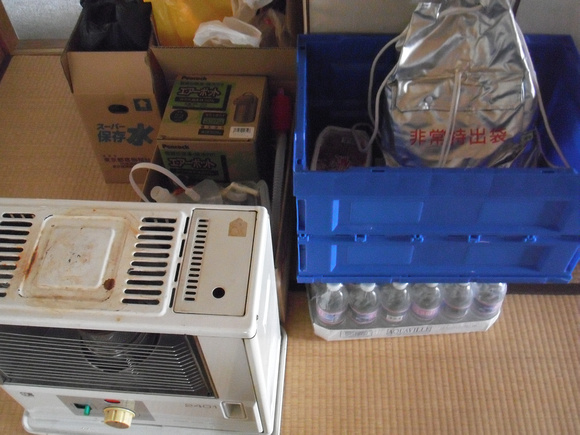我が家の非常物資。1年たっても、まだ片付けられない (After One Year, We Cannot Put Away Our Emergency Kits)
10年前に、老親たちが同居した時に、トランクルームにいっぱい非常物資を備蓄しました。br/ それは、とても役に立ちました。br/ 震災後にさらに非常食品を買い集めました。br/ 母の部屋の仏壇の脇に、まだ置いてあります。br/ 余震があるので、心配でしまえません。br/ ストーブの後ろには折りたたみ式の水タンク。br/ 停電の時は、13年前の旧式の石油ストーブが大活躍でした。暖房、調理、照明になりました。br/ そのストーブで沸いたお湯がもったいなかった。br/ でも電気ポットは保温できなかった。br/ そこで、電気を使わない保温ポットを震災後に買いました。br/ 昭和レトロなものが、エコなのです。br/ 「もう全部戻していいかな」と、何度も思ったけど、まだ片付けられません。br/ br/ span class="small"strong仙台のY/strongbr/ 宮城県仙台市 2012年3月 撮影/spanbr/ _______________________________br/ br/ br/ Ten years ago, when I lived with my parents, we prepared a lot of emergency kits in the storage room. They are very useful these days.br/ After the earthquake, we bought even more emergency kits. They are still placed beside the Buddhist altar in my motherrsquo;s room. We canrsquo;t put them away yet in fear of the aftershocks.br/ When the electricity was out, our 13-year-old kerosene heater really did a great job ndash; we used it a lot for heating, cooking and lighting.br/ Our electronic thermos couldnrsquo;t function without electricity, and the water we boiled on the kerosene heater just went to waste. That is why we bought a new thermos which does not need electricity.br/ It may be a bit ldquo;Showa Retrordquo;*, but it is eco-friendly.br/ I often wonder if these kits can finally be put away, but we still canrsquo;t do it.br/ br/ span class="small"strongY. in Sendai/strongbr/ Photo: Sendai City, Miyagi Prefecture, March 2012br/ *Translatorrsquo;s Note: Showa refers to the period from 1926-1989./span


